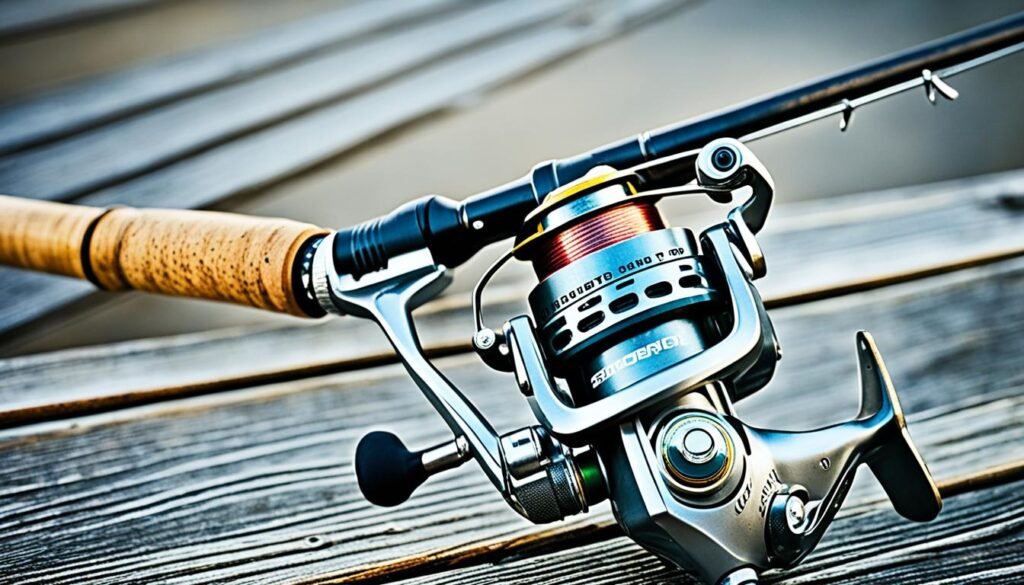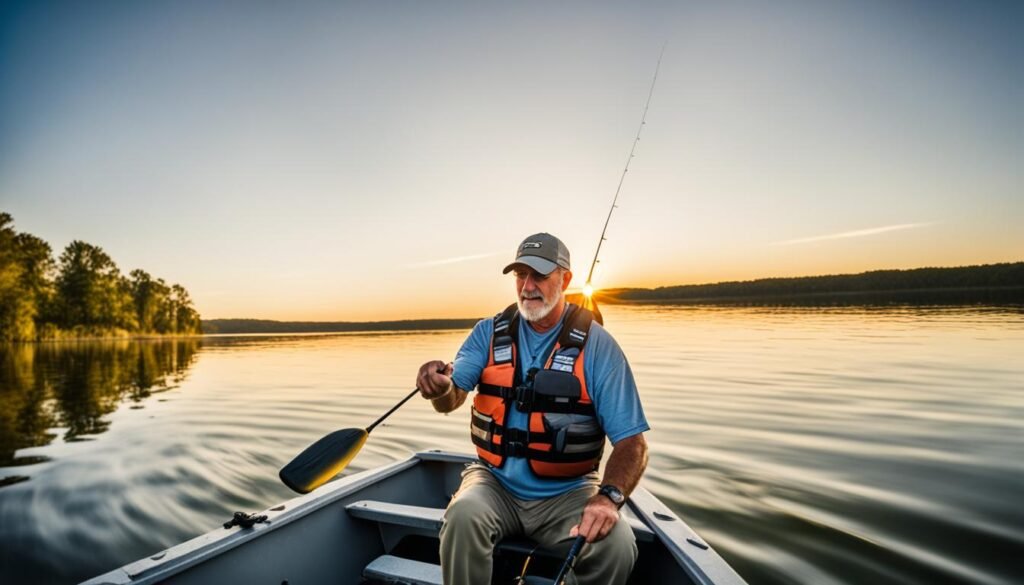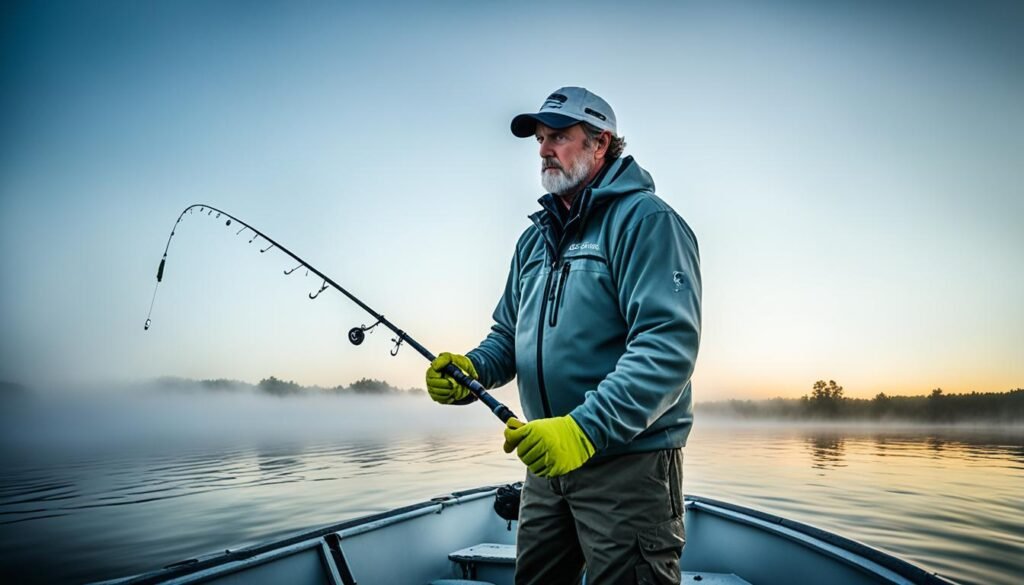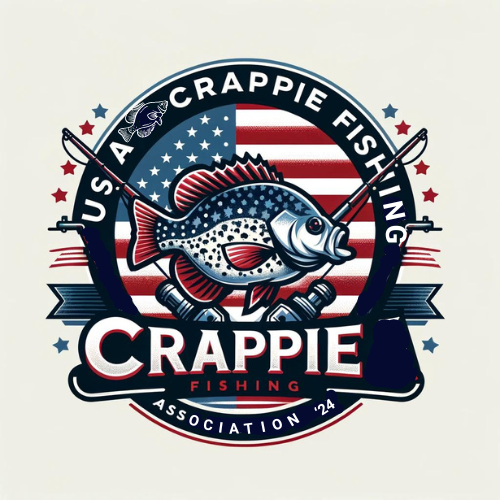“Fishing is much more than fish. It is the great occasion when we may return to the fine simplicity of our forefathers.” – Herbert Hoover
Crappie fishing is a beloved pastime that reconnects us with nature and taps into our ancestral instinct to provide for ourselves. Whether you’re a seasoned angler or just starting out, mastering the best crappie fishing approach is essential to elevate your game and increase your chances of success.
In this comprehensive guide, we will delve into the world of crappie fishing, uncovering expert strategies, proven tactics, and effective tips that will help you become a crappie fishing master. From understanding the behavior of crappie to selecting the right gear and techniques, we will equip you with the knowledge and skills to conquer any fishing expedition.
Key Takeaways:
- Explore the finesse and simplicity of crappie fishing techniques
- Discover the best approaches used by expert anglers
- Learn proven tactics for successful crappie fishing
- Equip yourself with effective advice to enhance your catch rate
- Uncover the hidden tricks and tips that top anglers rely on
Where to Find Crappie
Crappie, also known as speckled perch, are widely distributed in various bodies of water across the United States. Whether you’re fishing in lakes, reservoirs, rivers, ponds, or streams, you have the opportunity to encounter these popular game fish.
However, there are certain areas and habitats where crappie are more abundant. One notable region is the Crappie Belt, which includes states like Mississippi, Louisiana, Tennessee, and Texas. These states are known for their thriving crappie populations and offer excellent opportunities for anglers.
When searching for crappie, it’s important to consider their habitat preferences. They often seek shelter and cover near calm and shallow waters. Look for areas with brush, downed trees, timber, and weeds, as these provide ideal hiding spots for crappie.
To increase your chances of finding crappie, it’s also beneficial to explore areas with submerged structures such as submerged brush piles, submerged vegetation, and submerged logs. These structures attract crappie and provide them with food sources and protection.
Additionally, pay attention to water temperature and clarity. Crappie tend to prefer clearer water with temperatures ranging from 50 to 80 degrees Fahrenheit.
Here are some key points to keep in mind when searching for crappie:
- Look for calm and shallow waters
- Search for areas with brush, downed trees, timber, and weeds
- Explore submerged structures such as brush piles, vegetation, and logs
- Consider water temperature and clarity
By focusing your efforts on these habitats and locations, you’ll increase your chances of finding crappie and having a successful fishing trip.
Tackle and Gear for Crappie Fishing
To effectively catch crappie, you’ll need the right tackle and gear. Here are some key essentials for your crappie fishing arsenal:
Fishing Rod for Crappie
When it comes to choosing a fishing rod for crappie, a light or ultralight spinning rod is highly recommended. These rods offer the sensitivity and flexibility required for detecting subtle bites and landing crappie effectively. Popular rod brands for crappie fishing include Ozark and ACC.
Fishing Reel for Crappie
Pair your fishing rod with a quality spinning reel specifically designed for crappie fishing. Reputable brands like Daiwa, Lew’s, and Shimano offer a wide range of spinning reels that are lightweight, durable, and have smooth drag systems. Select a reel size that complements your rod and suits your personal preferences.
Fishing Line for Crappie
Choosing the right fishing line is essential for crappie fishing success. Opt for clear monofilament or fluorocarbon lines in the 4-8 lbs range. These line sizes provide adequate strength for reeling in crappie without overpowering them. Clear lines are less visible underwater and can increase your chances of getting a bite. Some popular fishing line brands include Berkley, Stren, and Seaguar.
Crappie Fishing Tackle
Investing in the right crappie fishing tackle is crucial for attracting and enticing these finicky fish. Artificial lures like jigs are highly effective for crappie fishing. Choose jigs in vibrant colors like chartreuse and blue-white to mimic the natural prey of crappie. Reputable jig brands such as Southern Pro, Z-Man, and Rapala offer a wide range of options to suit different fishing conditions and preferences. Additionally, live bait options such as minnows, worms, grubs, and crickets can also be effective for tempting crappie.
| Tackle and Gear | Features |
|---|---|
| Fishing Rod | Light or ultralight spinning rod |
| Fishing Reel | Quality spinning reel from brands like Daiwa, Lew’s, or Shimano |
| Fishing Line | Clear monofilament or fluorocarbon in the 4-8 lbs range |
| Crappie Fishing Tackle | Artificial lures like jigs or live bait options |
Remember, having the right tackle and gear is essential, but it’s also important to adapt your approach based on the specific fishing conditions and the behavior of crappie in your area. Experiment with different tackle and techniques to discover what works best for you. Now, you’re ready to hit the water and start reeling in those crappie!

Casting Techniques for Crappie Fishing
One of the most popular techniques for crappie fishing is casting. This method allows you to target crappie near the shoreline and is effective in both spring and fall.
When casting for crappie, it’s essential to use the right gear. A lightweight jighead, such as a 1/16-ounce jig, is ideal for this technique. The lightweight design allows for accurate and precise casting.
To maximize your chances of success, cast your line near areas with vegetation, stumps, or rocks. These locations provide hiding spots for crappie and are likely to attract their attention.
Once you’ve cast your line, it’s crucial to use the correct retrieve technique. The key is to let the jig do the work for you, mimicking the movement of a minnow. Retrieve your line slowly and steadily, maintaining a consistent speed.
By using this casting technique, you can effectively imitate natural prey and entice crappie to bite. It allows you to cover a larger area and increases your chances of encountering these elusive fish.
Benefits of Casting Techniques for Crappie Fishing:
- Targets crappie near the shoreline
- Effective in both spring and fall
- Allows for accurate and precise casting
- Covers a larger area to increase chances of success
Mastering the art of casting for crappie fishing can significantly enhance your fishing experience. By using the right gear and employing proper techniques, you’ll be well on your way to reeling in those prized crappie.
Vertical Jigging for Crappie
Vertical jigging is a highly effective technique for crappie fishing. By utilizing this method, anglers can entice crappie to bite with enticing movements that mimic a swimming minnow. Whether you’re fishing from a boat or the shore, vertical jigging can help you achieve success in your crappie fishing endeavors.
To execute vertical jigging, begin by dropping your line in shallower water, about a foot from the bottom. Use a brightly colored stinger jig or live bait, such as minnows, to attract the attention of crappie. Once your line is in position, gently raise it one to three feet and allow it to fall back to the original spot. This action imitates the natural movement of a minnow and triggers the predatory instincts of crappie, enticing them to strike.
Key Steps for Vertical Jigging:
- Drop your line in shallower water, about a foot from the bottom.
- Use a brightly colored stinger jig or live bait as a lure.
- Gently raise the line one to three feet and allow it to fall back to the original spot.
- Repeat the vertical jigging retrieve to maximize your chances of attracting crappie.
Vertical jigging is particularly effective during the spring when crappie are actively feeding in shallower waters. This technique allows you to cover a vertical range of the water column and target crappie that may be suspending or holding near the structure. Be patient and experiment with different colors and jigging speeds to find what works best for the specific conditions and preferences of the crappie in your fishing area.
Take your vertical jigging game to the next level with the right equipment and bait choices. Combine your technique with a responsive spinning rod and reel combo, suitable line strength, and vibrant jigs or live bait options to increase your chances of success. Remember, practice and persistence are key to mastering vertical jigging for crappie.
| Benefits of Vertical Jigging for Crappie | Challenges of Vertical Jigging for Crappie |
|---|---|
| – Highly effective technique | – Requires practice and finesse |
| – Mimics natural swimming movements | – May require adjustments based on water conditions |
| – Targets crappie in vertical water column | – Requires proper equipment and bait selection |
| – Can be done from a boat or shore | – Success may vary depending on crappie behavior |
Trolling for Crappie
Trolling is a highly effective technique for crappie fishing, especially when targeting scattered crappie across a large area of water. By spreading out multiple rods equipped with jigs or crankbaits in front of your boat, you can cover more ground and increase your chances of attracting crappie to your bait.
To successfully troll for crappie, it’s important to maintain a slow speed of around one to two miles per hour. This speed allows the jigs or crankbaits to mimic the movement of natural prey, enticing crappie to strike. Remember to experiment with different depths and colors to find what works best in your fishing location.
Trolling is particularly effective during the summer months when crappie tend to be more spread out. By trolling, you can search for active crappie in different areas of the water body, increasing your chances of success.

“Trolling is a great technique for covering a large area of water and targeting scattered crappie.”
Shooting Docks for Crappie
Shooting docks is a highly effective technique for targeting crappie that seek shelter near or under docks. By employing this technique, you can significantly increase your chances of landing a catch. Here’s how to master the shooting docks method:
- Locate the Fish: Use sonar to identify crappie hiding beneath the docks. Begin on the shallow side of the docks, where the shade offers a favorable environment for crappie.
- Prepare for Launch: Take your bait in hand and grasp the rod firmly. Position yourself to shoot the bait deep into the docks.
- Launch with Precision: Utilize the elasticity of the rod to propel your bait directly into the targeted area. This sudden, accurate movement generates excitement among nearby fish, triggering a bite response.
- Observe Subtle Signs: Pay close attention to any movements in the line or rod tip, as crappie bites can be discreet. Quick reflexes and attentiveness are key to successfully detect these bites.
Remember, the shooting docks technique requires practice and precision. Be patient and persistent, and with time, you’ll become adept at mastering this skill.

To further illustrate the effectiveness of shooting docks for crappie, here’s a table highlighting the advantages of this technique compared to other common methods:
| Technique | Advantages of Shooting Docks |
|---|---|
| Casting | Targets specific areas near docks where crappie congregate |
| Vertical Jigging | Offers a different presentation that can entice bites from dock-dwelling crappie |
| Trolling | Provides a more precise and controlled approach when fishing in confined dock spaces |
Pushing Jigs for Crappie
When it comes to targeting active crappie in cover, the pushing jigs technique can be highly effective. By slowly trolling with the trolling motor, you can push your jigs forward through cover, enticing crappie to bite. This technique is particularly useful in shallow water where crappie tend to seek shelter.
To successfully push jigs for crappie, it’s important to adjust your trolling speed and the depth at which your jigs are presented. Experimentation is key to finding the most effective combination for enticing crappie bites. Remember to stay observant and adapt your approach based on the behavior of the fish.
When implementing the pushing jigs technique, it’s crucial to use the right equipment. You’ll need a lightweight jighead, such as a 1/16-ounce jig, to minimize disruption of the water when pushing your jigs through cover. A light or ultralight spinning rod paired with a quality spinning reel will provide the necessary sensitivity and control.

Benefits of Pushing Jigs for Crappie
Pushing jigs for crappie offers several advantages:
- Targeting active crappie in cover: The pushing jigs technique allows you to effectively target crappie that are positioned in cover but not actively feeding. By bringing the jigs to them, you increase your chances of enticing a bite.
- Versatility in shallow water: This technique excels in shallow water where crappie seek shelter. By pushing jigs through the shallows, you can reach the areas where crappie are hiding.
- Adaptable to different cover types: Whether you’re fishing around vegetation, stumps, or submerged structures, pushing jigs allows you to navigate through various types of cover to reach crappie.
Best Baits for Crappie
Choosing the right bait is crucial for crappie fishing success. When it comes to artificial lures, jigs are highly effective for enticing crappie bites. To increase your chances of attracting crappie, opt for jigs in vibrant colors like chartreuse and blue-white. These colors mimic the appearance of natural prey and catch the attention of crappie in murky waters. Reputable brands such as Southern Pro, Z-Man, and Rapala offer a wide range of high-quality jigs that are known to produce excellent results.
If you prefer using live bait, minnows are a popular and effective option. Crappie are natural predators and are naturally drawn to the movement of live bait. You can use a small hook to secure the minnow and allow it to swim freely in the water, enticing crappie to strike. Additionally, various insects like worms, grubs, and crickets can also be used as live bait options. These critters can be irresistible to hungry crappie and can be easily found at your local bait shop or collected from your surroundings.
It’s important to experiment with different baits to determine what works best in your specific fishing location. Crappie can be picky eaters, and their preferences can vary based on factors such as water clarity, temperature, and time of year. By trying out different baits and observing the reactions of the crappie in your area, you’ll be able to fine-tune your bait selection and increase your chances of hooking more crappie.
Comparison of Crappie Bait Options
| Bait Type | Advantages | Disadvantages |
|---|---|---|
| Jigs | – Highly effective – Mimics natural prey – Wide color selection |
– Requires practice to master – May get snagged on underwater structures |
| Minnows | – Natural movement attracts crappie – Easy to find at bait shops |
– Requires live bait container or frequent bait changes – May be challenging to keep alive on the water |
| Insects (worms, grubs, crickets, etc.) | – Can be irresistible to hungry crappie – Readily available in nature |
– May require patience to collect or purchase – Some crappie may be less responsive to insects |
Tips for Crappie Fishing in Different Seasons
Crappie behavior varies depending on the season, so adjusting your techniques accordingly can greatly improve your catch rate. Here are some tips for crappie fishing in different seasons:
Crappie Fishing in Spring
In the spring, focus on shallow areas near cover as crappie move to spawn. Look for areas with submerged vegetation, fallen trees, or docks. These spots provide ideal spawning grounds for crappie. Use techniques like casting or shooting docks to target these areas and entice bites. Crappie tend to be more active and aggressive during this time, making it an excellent season for fishing.
Crappie Fishing in Fall
During the fall, target areas with structure and cool water where crappie gather in preparation for winter. Look for underwater trees, submerged brush piles, or rocky areas. As the water temperature cools down, crappie will move to these areas in search of food. Use techniques like vertical jigging or trolling to cover a larger area and increase your chances of finding crappie.
Crappie Fishing in Winter
In winter, crappie tend to move to deeper waters, where the temperature is more stable. Look for drop-offs, channels, or deeper structure. Adjust your presentation by using slow and subtle techniques. Vertical jigging with live bait or small jigs can be effective when fishing deeper waters. Pay close attention to your sonar to locate schools of crappie and adjust your tactics accordingly.
Crappie Fishing in Summer
During the summer, crappie will often move towards deeper structure in search of cooler water and forage. Look for submerged trees, brush piles, or rock formations. Trolling or vertical jigging can be effective techniques to cover a larger area and locate crappie. Experiment with different depths and colors to find what works best in your fishing location. Be patient and persistent as crappie may be more scattered during this season.
Remember, seasonal changes affect crappie behavior, so adapting your techniques and locations accordingly can significantly improve your success rate. Stay observant and open to experimenting with different approaches to maximize your crappie fishing experience.
Crappie Fishing Q&A
Have some burning questions about crappie fishing? We’ve got the answers you’re looking for. Check out the Q&A below for expert advice and tips.
Q1: What is the best time of day to fish for crappie?
A1: Crappie are more active during low-light conditions, such as early morning or late afternoon/evening. These times provide optimal feeding opportunities for crappie, increasing your chances of a successful catch.
Conclusion
Crappie fishing is an incredibly rewarding and exhilarating experience that can be enjoyed by anglers of all ages and skill levels. Throughout this comprehensive guide, we have explored various crappie fishing techniques, tips, and strategies to help you become a master angler. By learning the right techniques, using the proper gear and baits, and understanding the behavior of crappie in different seasons, you can significantly improve your chances of success on the water.
It is important to remember that as anglers, we have a responsibility to protect the crappie population and preserve the sport for future generations. Always adhere to fishing regulations, including size and bag limits, and consider practicing catch-and-release whenever possible. This ensures that crappie populations remain healthy and abundant for years to come.
Now that you have equipped yourself with the knowledge and skills needed for successful crappie fishing, it’s time to apply what you’ve learned and hit the water. Whether you choose to cast, jig, troll, or shoot docks, remember to stay patient, observe the behavior of crappie, and adapt your techniques accordingly. We hope that this guide has provided you with valuable insights and inspiration for your next crappie fishing adventure. So grab your gear, head to your favorite fishing spot, and enjoy the thrill of reeling in some impressive crappie!
